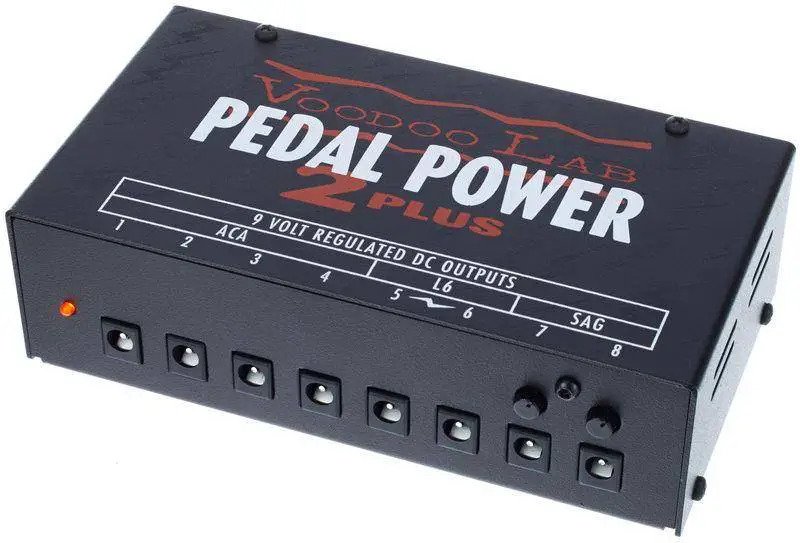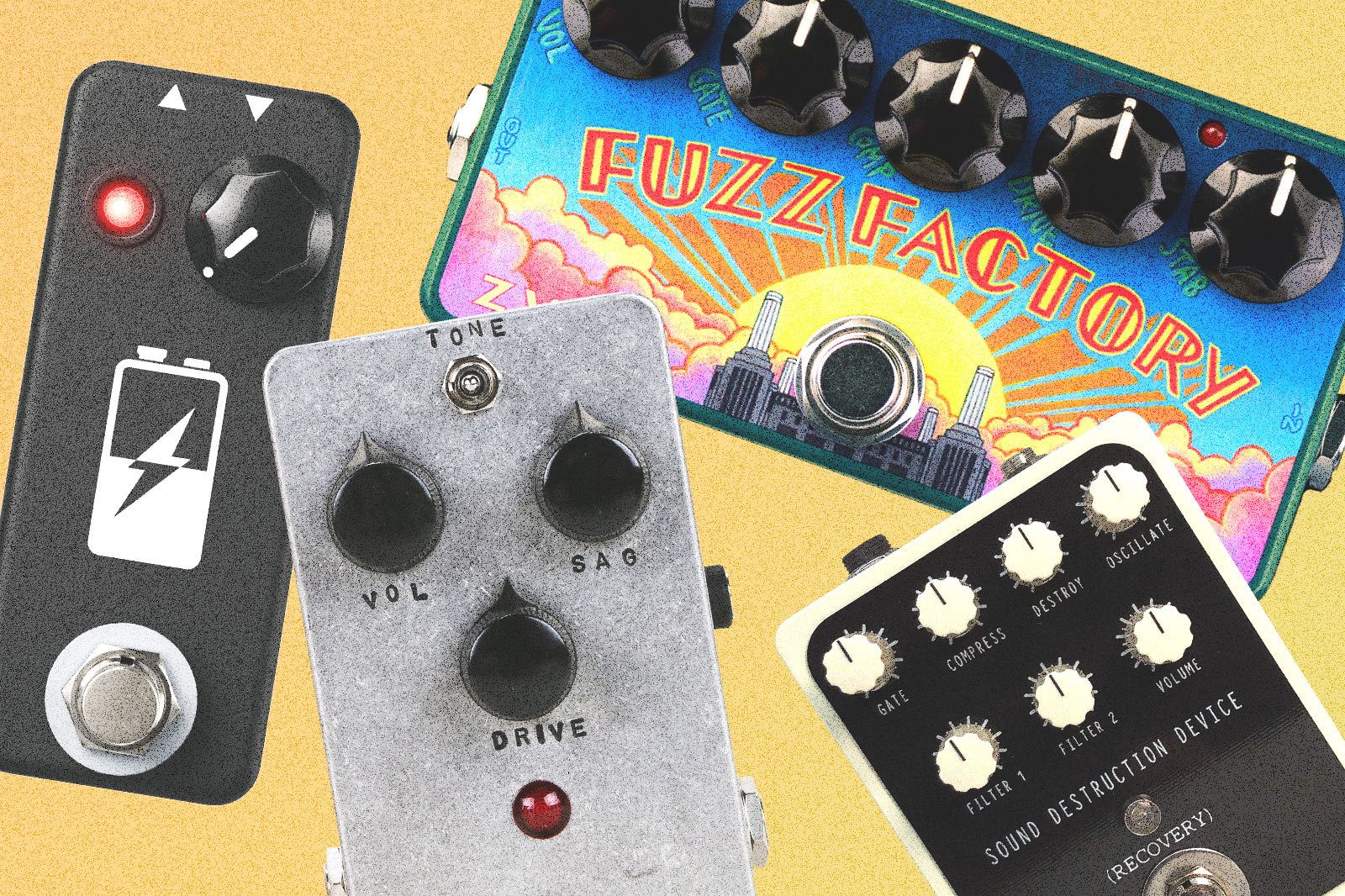Every guitar pedal needs power to function. Whether it’s getting juice from a power supply like the Voodoo Lab Pedal Power Plus 3 or a simple 9V battery, something has to provide voltage to the circuit.
All pedals run at an ideal operating voltage. The majority of them are rated for 9V, but it’s not uncommon for some (especially overdrives and distortions) to run at 12V, 18V, or even 24V. Providing these pedals with adequate power ensures that they operate the way that the manufacturer intends—making them predictable and reliable. But...have you ever thought about what happens if you underpower a pedal?
You wouldn't be the first. This is the key concept behind a technique with various names: "voltage sag," "power starvation," etc.
Let’s explore what voltage sag is, why it’s an appealing technique for guitar tone, the types of pedals you can and can’t use it with, and some important precautions to consider when using it.
What is Voltage Sag?
Voltage sag refers to dropping the voltage of the source that’s powering your pedals from its ideal level. In amplifiers, this affects the way the amp responds—and this is true for effects pedals too. Many amps even have a sag control that gives you a precise way to manipulate it.
But when it comes to effects pedals, things get a little more interesting. When fuzz pedals started becoming popular in the '60s, it didn’t take long for guitarists to discover that running them at a lower voltage produced a unique, rougher sound. That’s saying a lot for a fuzz!
Many vintage guitar pedals relied on batteries for power—and early on, players realized that letting their batteries run out of "juice" could significantly affect the resulting sound. It doesn’t seem like much, but there is a whole spectrum of possible tones between a fully-charged battery and one that’s drained. Older fuzz pedals like the Dunlop Fuzz Face are especially well known to benefit from voltage sag. Today, you can do this with a dedicated control on some pedal power supplies too, which we’ll touch on later.
It takes their already hard clipped, nasty sound and takes it to new extremes. Some players even like using voltage sag with other gain pedals like compressors—for instance, the MXR Dyna Comp.
What is Sag in Guitar Pedals?
There are a few ways to achieve voltage sag in guitar pedals. Some even come with it as a dedicated control feature. But there is some confusion with a lot of players on what types of pedals the technique can and can't be used with, and if it can cause damage to the pedal’s circuitry.
Whether you’re using a professional battery, power supply, daisy chain, or power strip from the hardware store there are three things to consider: voltage, polarity, and amperage. As a general rule, you should always run pedals at the designated voltage or you could risk damaging them. For example, if you use an 18V adapter on a pedal rated for 9V it could fry it.
But...let's talk about some of the ways you can break that rule. Proceed with caution—and read this whole article before you start underpowering your pedals, as it is not safe for every pedal under the sun.
Dying Batteries
Let’s start at the beginning. Batteries that weren’t fully charged was the first way guitarists realized voltage sag had positive sound benefits. It's even rumored that Dwayne Allman of the Allman Brothers kept a box of partly used 9V batteries for his Fuzz Face because of the distinct sound it provided.
Power supplies as we know them today didn’t exist yet, so batteries were the primary option for providing power to guitar pedals for many years.

Variable-Voltage Power Supplies
A lot of guitar pedal power supplies come with a few outputs that offer a sag control. This simulates the underpowered battery effect and provides a more precise way to control the amount of sag.
Power supplies like the Voodoo Lab Pedal Power 2 or CIOKS CIOKolate offer outputs at varying voltage levels. They feature a few outputs that let you dial in the exact amount of sag you want via a potentiometer. You just have to make sure the pedals you’re connecting are rated for the individual power output they’re connected to on the supply.
Voltage Sag Pedals
Some companies make dedicated voltage sag pedals. The JHS Volture is a perfect example. It sits between the pedal’s power supply and the power jack on the pedal. A single knob lets you set the exact amount of voltage sag, and a footswitch lets you engage it.
This gives you multiple sounds out of a single pedal. It works with any 9V analog pedal too! Just beware—it won’t sound great with every pedal.
What Pedals Work with Voltage Sag?
The general consensus in the guitar community is that gain effects like fuzzes, distortions, overdrives, and octave pedals get the most benefits from voltage sag. And it works best with transistor-based gain pedals. Fuzz pedals like the Keeley Fuzz Bender, distortions, and overdrives often work great.
In general, any analog pedal is a candidate for voltage sagging, but fuzz pedals are the most common type that benefits. A lot of players think Big Muff-style pedals just sound better at lower voltages. And there are plenty of newer models like the EHX Germanium 4 Big Muff Pi and Fairfield Circuitry Barbershop that offer dedicated sag controls. Many variants of the ZVEX Fuzz Factory feature a similar control, labeled "Stab" (short for "Stability").
Op-amps (ICs) are often used in gain pedals as an alternative build topology to transistors, and are much less affected by voltage variations. So they won’t produce the same results that transistor-based circuits will.
What Pedals Don’t Work with Voltage Sag?
Voltage sag doesn’t work with every kind of pedal. Digital pedals are a good example. Due to their design and the DSP chips they run on, digital pedals require a specific amount of voltage—reducing the voltage level going to your digital pedals won't help the tone, and will risk ruining your pedal. Just don't try this technique with digital pedals, period.
And though analog gain pedals can utilize it, many all-analog pedals just won’t sound good. Modulation, analog delays, and filter effects like equalizers and wahs typically sound best run at their optimal voltage.
Proceed with Caution!
It’s important to note that while dropping the voltage won’t cause any harm to your effects pedals, giving them more voltage than they’re designed for can absolutely fry them. It could happen immediately or over time.Some pedal circuits are designed with overvoltage protection, but even that can fail if they’re getting too much.
There are plenty of 9V pedals designed to operate at optional higher voltages like 12V or 18V, but most have a specific voltage rating. Using a power supply with voltage lower than a pedal needs to simulate voltage sag can cause damage as well.
Think of it this way. “Undervolting” can produce some cool sounds in analog pedals, but “overvolting” is always risky. Never feed a pedal more voltage than it’s rated for. And remember, underpowering digital pedals is, generally speaking, a big no-no.
Make sure to check the manual to be safe.
Conclusion
Voltage sag is an interesting way to experiment with tone and get more out of your guitar pedals. Due to the voltage differential, it opens up new sounds by changing the way the circuit responds and reacts.
It’s by no means a new concept, but it's just as viable today as it was 60 years ago. With advancements in power supply sources you can now tailor the exact amount of voltage sag you want. This lets you explore a wider spectrum than relying on whatever level a battery is at. And what guitar player doesn’t like to experiment with their tone?
The best part? You don't have to carry around a bunch of dying batteries like Duane Allman did.
Brandon Stoner is a lifelong musician and audio engineer who owns more guitars than anyone needs. As a lover of all things writing and music technology, he crafts every piece with his dog Max on his lap.












